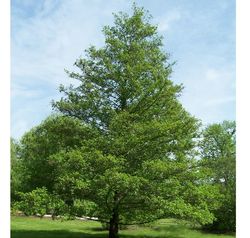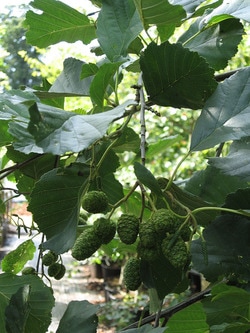ALNUS TREEALNUS GLUTINOSA – Common Alder
A large native tree which is common by riverbanks and damp places, it can grow to 25m (80ft) but is often coppiced and appears in a multi-stemmed form.
History
Mespilus germanica is apparently native only to southwest Asia and southeastern Europe, i.e. near the Black Sea coast and western Mediterranean, and Asia Minor, as well as the Caucasus and northern Iran, but it has an ancient history of cultivation and wild plants exist in a much wider area; it was grown by the ancient Greeks and Romans, beginning in the second century BC. Mespilus germanica was a very popular fruit in Western Europe during the Victorian era but has fallen out of favour there.
DescriptionA fast-growing, medium-sized native tree found all over Britain, especially in wet places. Very hardy and coping with a wide range of soil types, Alder is particularly useful for preventing soil erosion, and for establishing plantings in waterlogged areas. Young plants are seldom attacked by rabbits or stock, so makes a good choice where this could be a problem.
Site and soilAlder tolerates a wide range of soils and situations, except very dry conditions. It will grow well on damp hillsides and in boggy, waterlogged sites.
Height and spreadAfter 10 years: 8m x 2.5m
After 20 years: 9m x 3.7m
Leaf and barkThe leaves are ovate, and glossy dark green, and deeply lobed, rather like an oak, and about 5cm long. The bark is a greyish dark brown, cracked into thin rectangular plates.
Flower, seed and fruitMale catkins of Alder can be seen as a purplish haze among the branches as early as January, opening to a dull yellow in March and April. Female catkins are very short (0.5cm), becoming woody 'cones' over winter which are a useful source of food for native birds.
Alder is monoecious; so both male and female flowers are found on the same tree. Male catkins appear before the leaves and are yellow and pendulous 2–6cm. Female flowers are green and oval-shaped, three to eight on each stalk.
Alders are wind pollinated; the wind carries pollen from male to female flowers. In autumn the female catkins become woody resembling small pine cones. The scales open to release seeds which are dispersed via wind and water.
UsesAlder wood is relatively soft and porous and is only durable if kept under water. Once it is seasoned the wood is pinkish-brown.
Modern uses for alder timber include veneers, pulp and plywood. Traditionally, it has been used for making sluice gates, water pipes, bridge piles and small boats.
Alder can be coppiced and is suitable for making charcoal. In the past its charcoal was favoured for gunpowder. Alder was also a traditional timber for turnery work and was used to make clogs and broom handles.
Alder roots contain bacteria nodules which enable them to ‘fix’ atmospheric nitrogen returning it to the soil and improving ground conditions. Its ability to stabilise soils in wet conditions also makes it an ideal tree to assist in flood mitigation.
In folklore the alder was feared as the timber is white when freshly cut but rapidly turns blood-orange; making the tree appear to bleed.
Did you know?
The timber is hard and durable and has had a number of uses including the charcoal used in gunpowder. However one of the chief uses used to be clogs, the clog makers travelled from place to place and purchased standing timber which they felled and roughed into shape on the spot.
WildlifeAlder fruits (false cones) are a useful source of food for birds in spring. The catkins are an early source of pollen and the trees provide shelter on wetland sites.
A large native tree which is common by riverbanks and damp places, it can grow to 25m (80ft) but is often coppiced and appears in a multi-stemmed form.
History
Mespilus germanica is apparently native only to southwest Asia and southeastern Europe, i.e. near the Black Sea coast and western Mediterranean, and Asia Minor, as well as the Caucasus and northern Iran, but it has an ancient history of cultivation and wild plants exist in a much wider area; it was grown by the ancient Greeks and Romans, beginning in the second century BC. Mespilus germanica was a very popular fruit in Western Europe during the Victorian era but has fallen out of favour there.
DescriptionA fast-growing, medium-sized native tree found all over Britain, especially in wet places. Very hardy and coping with a wide range of soil types, Alder is particularly useful for preventing soil erosion, and for establishing plantings in waterlogged areas. Young plants are seldom attacked by rabbits or stock, so makes a good choice where this could be a problem.
Site and soilAlder tolerates a wide range of soils and situations, except very dry conditions. It will grow well on damp hillsides and in boggy, waterlogged sites.
Height and spreadAfter 10 years: 8m x 2.5m
After 20 years: 9m x 3.7m
Leaf and barkThe leaves are ovate, and glossy dark green, and deeply lobed, rather like an oak, and about 5cm long. The bark is a greyish dark brown, cracked into thin rectangular plates.
Flower, seed and fruitMale catkins of Alder can be seen as a purplish haze among the branches as early as January, opening to a dull yellow in March and April. Female catkins are very short (0.5cm), becoming woody 'cones' over winter which are a useful source of food for native birds.
Alder is monoecious; so both male and female flowers are found on the same tree. Male catkins appear before the leaves and are yellow and pendulous 2–6cm. Female flowers are green and oval-shaped, three to eight on each stalk.
Alders are wind pollinated; the wind carries pollen from male to female flowers. In autumn the female catkins become woody resembling small pine cones. The scales open to release seeds which are dispersed via wind and water.
UsesAlder wood is relatively soft and porous and is only durable if kept under water. Once it is seasoned the wood is pinkish-brown.
Modern uses for alder timber include veneers, pulp and plywood. Traditionally, it has been used for making sluice gates, water pipes, bridge piles and small boats.
Alder can be coppiced and is suitable for making charcoal. In the past its charcoal was favoured for gunpowder. Alder was also a traditional timber for turnery work and was used to make clogs and broom handles.
Alder roots contain bacteria nodules which enable them to ‘fix’ atmospheric nitrogen returning it to the soil and improving ground conditions. Its ability to stabilise soils in wet conditions also makes it an ideal tree to assist in flood mitigation.
In folklore the alder was feared as the timber is white when freshly cut but rapidly turns blood-orange; making the tree appear to bleed.
Did you know?
The timber is hard and durable and has had a number of uses including the charcoal used in gunpowder. However one of the chief uses used to be clogs, the clog makers travelled from place to place and purchased standing timber which they felled and roughed into shape on the spot.
WildlifeAlder fruits (false cones) are a useful source of food for birds in spring. The catkins are an early source of pollen and the trees provide shelter on wetland sites.

